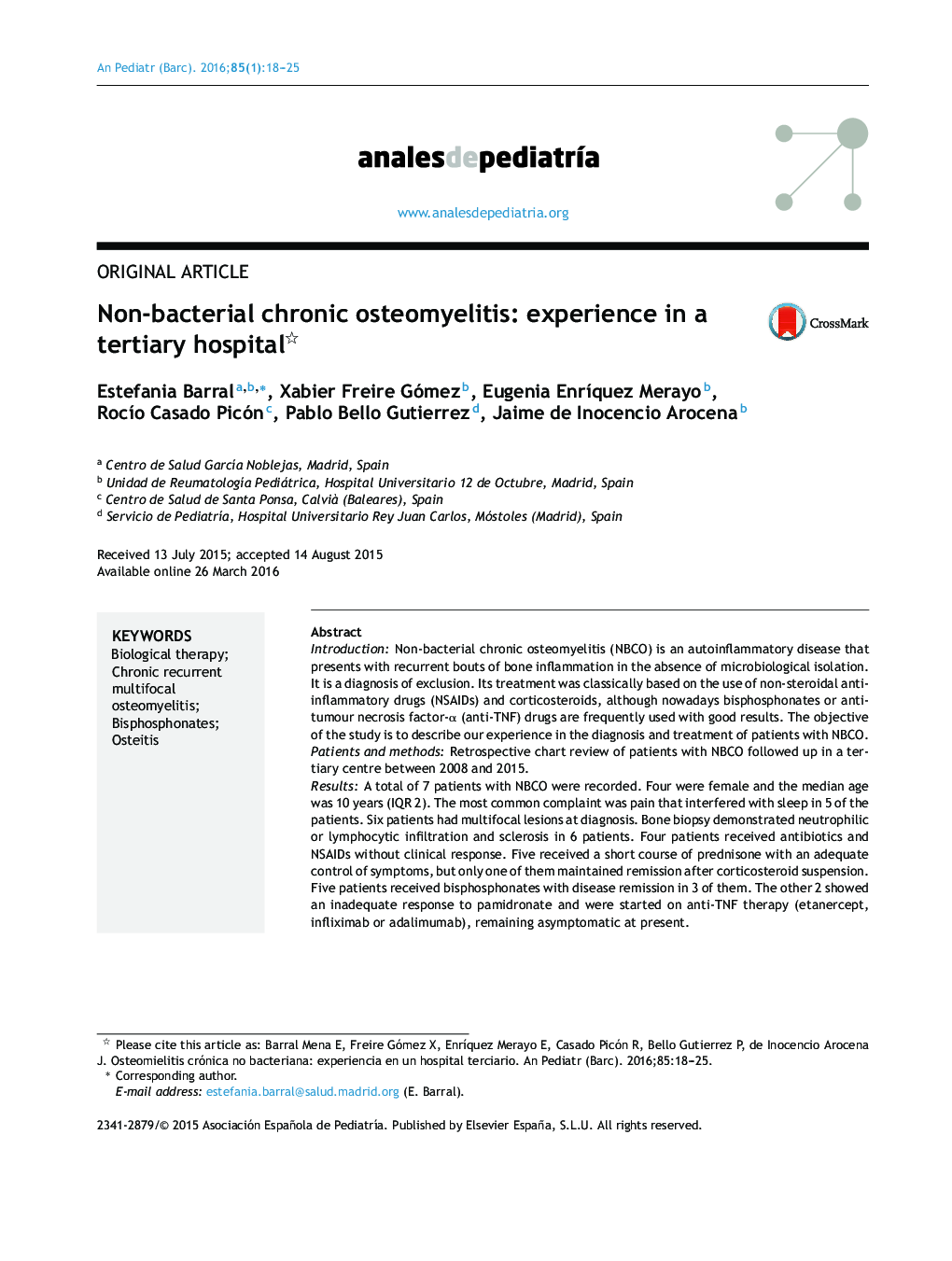| کد مقاله | کد نشریه | سال انتشار | مقاله انگلیسی | نسخه تمام متن |
|---|---|---|---|---|
| 4144956 | 1272577 | 2016 | 8 صفحه PDF | دانلود رایگان |
IntroductionNon-bacterial chronic osteomyelitis (NBCO) is an autoinflammatory disease that presents with recurrent bouts of bone inflammation in the absence of microbiological isolation. It is a diagnosis of exclusion. Its treatment was classically based on the use of non-steroidal anti-inflammatory drugs (NSAIDs) and corticosteroids, although nowadays bisphosphonates or anti-tumour necrosis factor-α (anti-TNF) drugs are frequently used with good results. The objective of the study is to describe our experience in the diagnosis and treatment of patients with NBCO.Patients and methodsRetrospective chart review of patients with NBCO followed up in a tertiary centre between 2008 and 2015.ResultsA total of 7 patients with NBCO were recorded. Four were female and the median age was 10 years (IQR 2). The most common complaint was pain that interfered with sleep in 5 of the patients. Six patients had multifocal lesions at diagnosis. Bone biopsy demonstrated neutrophilic or lymphocytic infiltration and sclerosis in 6 patients. Four patients received antibiotics and NSAIDs without clinical response. Five received a short course of prednisone with an adequate control of symptoms, but only one of them maintained remission after corticosteroid suspension. Five patients received bisphosphonates with disease remission in 3 of them. The other 2 showed an inadequate response to pamidronate and were started on anti-TNF therapy (etanercept, infliximab or adalimumab), remaining asymptomatic at present.ConclusionsOur series, although limited, confirms the effectiveness and safety of bisphosphonate and anti-TNF therapy for children with NBCO.
ResumenIntroducciónLa osteítis crónica no bacteriana (OCNB) es una enfermedad autoinflamatoria que cursa con brotes de inflamación ósea en ausencia de aislamiento microbiológico. Su diagnóstico es de exclusión. El tratamiento se basaba en la utilización de antiinflamatorios no esteroideos (AINE) y esteroideos aunque cada vez con mayor frecuencia se utilizan bifosfonatos o fármacos contra el factor de necrosis tumoral α (anti-TNFα) con buenos resultados. El objetivo es revisar nuestra experiencia en el diagnóstico y tratamiento de estos pacientes.Pacientes y métodosRevisión retrospectiva de las historias clínicas de los pacientes diagnosticados de OCNB entre 2008 y 2015 en un hospital terciario.ResultadosDe un total de 7 pacientes, 4 eran mujeres, con una mediana de edad de 10 años (RIQ 2). El motivo más frecuente de consulta fue dolor que interfería con el sueño en 5 pacientes. Seis presentaron lesiones multifocales al diagnóstico. En 6 se realizó biopsia ósea que demostró un infiltrado neutrofílico o linfocitario y esclerosis. Cuatro pacientes recibieron tratamiento antibiótico y AINE sin respuesta clínica. Cinco pacientes recibieron prednisona, consiguiéndose control sintomático que solo mantuvo uno tras su suspensión. Cinco recibieron bifosfonatos con remisión de la enfermedad en 3. Dos pacientes presentaron una respuesta insuficiente a pamidronato, por lo que recibieron terapia anti-TNFα (etanercept, infliximab o adalimumab) y se mantienen asintomáticos en la actualidad.ConclusionesNuestra serie, aunque limitada, confirma la efectividad y seguridad de la terapia con bifosfonatos y fármacos biológicos en pacientes con OCNB.
Journal: Anales de Pediatría (English Edition) - Volume 85, Issue 1, July 2016, Pages 18–25
